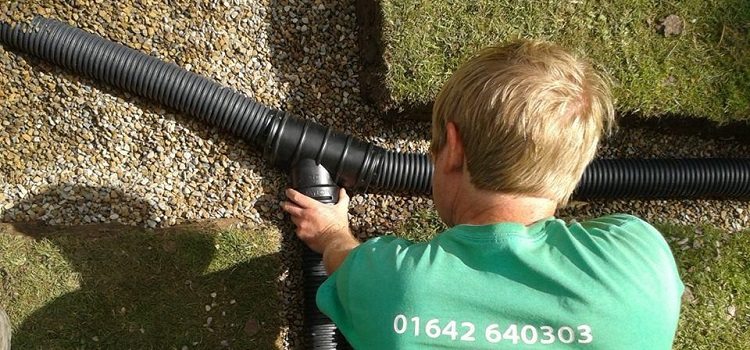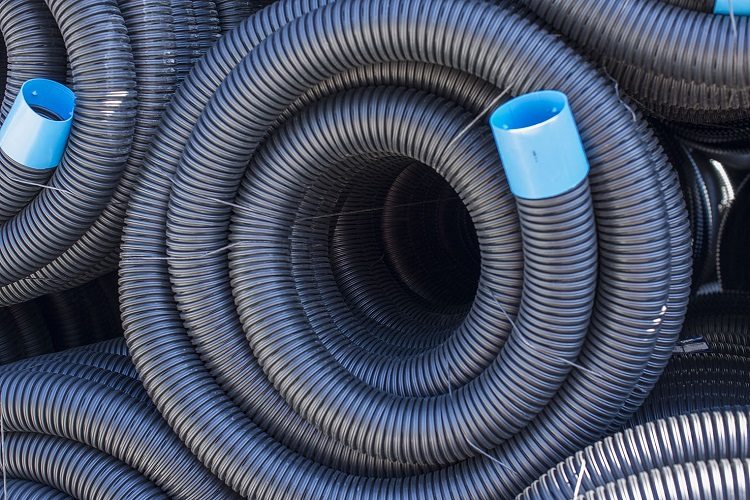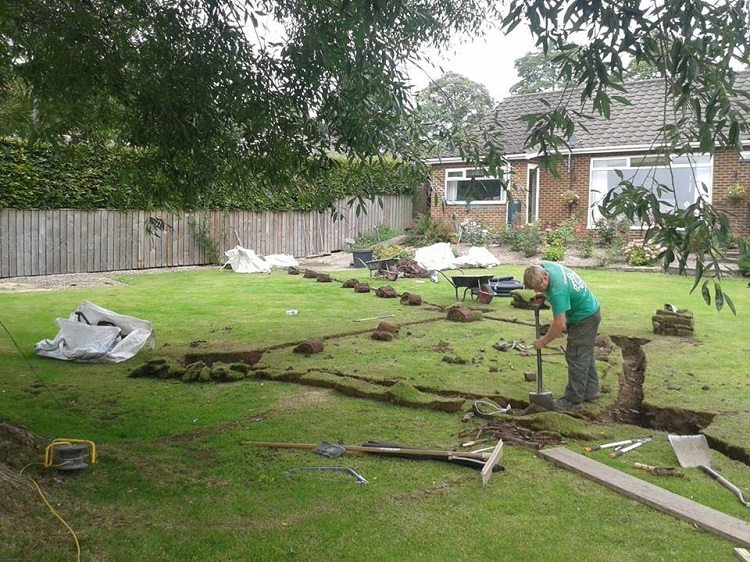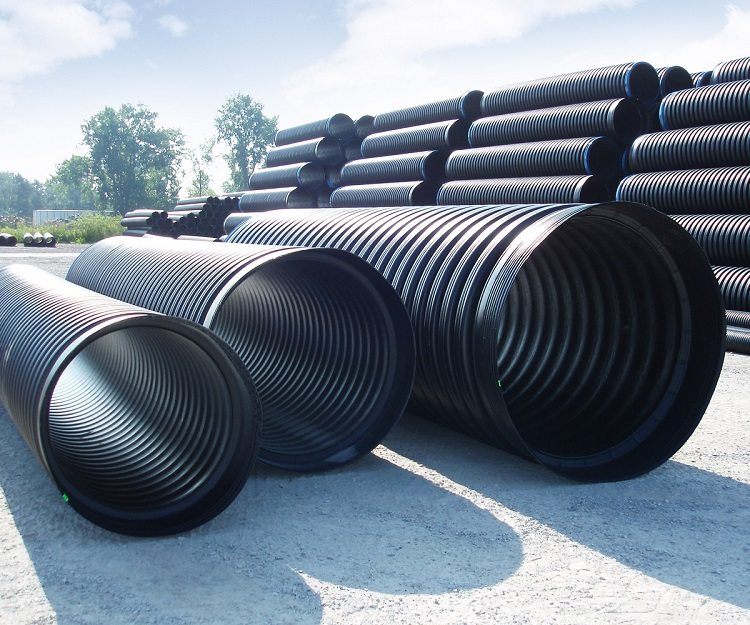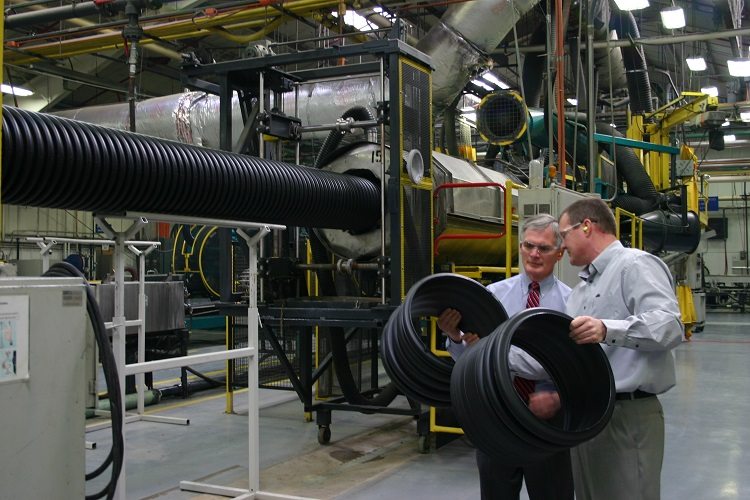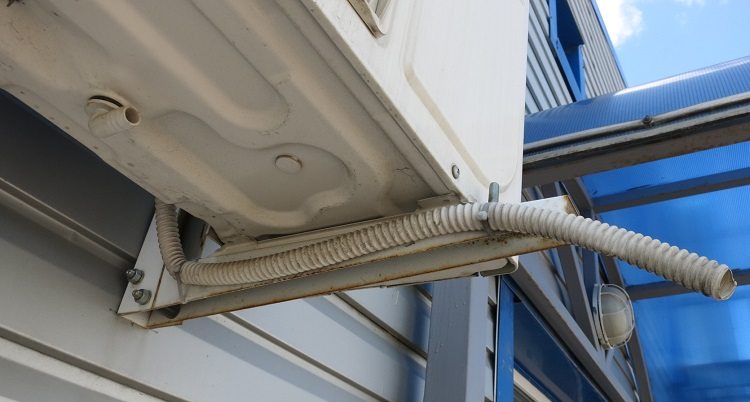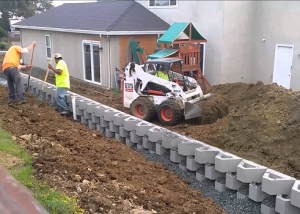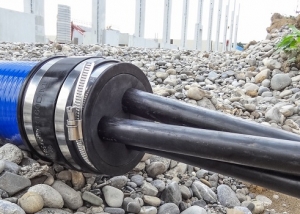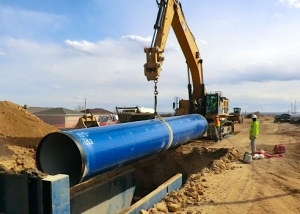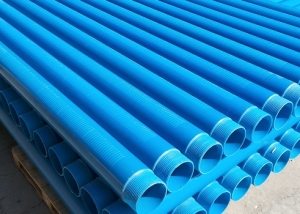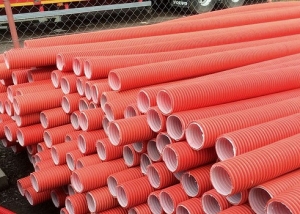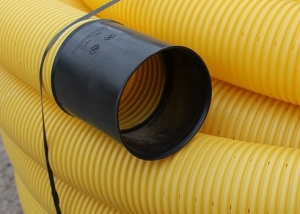The arrangement of a summer cottage requires the mandatory planning of drainage. Its presence will prevent flooding, as well as the negative impact of dampness on existing buildings. To develop the circuit, suitable drainage pipes will be needed. They can be from various materials: plastic (from HDPE and PVC), and ceramic, and asbestos-cement. Smooth either corrugated drainage pipes. In addition, plastic pipes are part of air conditioners.
Content
- 1 The need for drainage pipes
- 2 Product Requirements
- 3 Important points when installing a drainage system
- 4 The main types of drainage pipes
- 5 Ceramic and asbestos-cement products
- 6 The advantages of plastic drainage pipes
- 7 Assortment of plastic drainage channels
- 8 PVC products
- 9 HDPE drainage pipes
- 10 Pipe slope
- 11 Selection of drainage parameters
- 12 Network installation steps
- 13 Using a drain pipe for an air conditioner
- 14 Installation Errors
The need for drainage pipes
Ideal conditions when the site is almost flat and the soil is waterproof and fertile are rare. One of the main reasons for subsidence or destruction of the foundation is the influence of groundwater. Installing a pipe for drainage of the site can save all sorts of buildings and the required area from the negative effects, which include:
- high humidity, creating an uncomfortable microclimate in the room;
- freezing walls;
- the formation of mold and fungal colonies;
- flooding of cellars, as well as basements;
- waterlogging of the soil and, as a consequence, the death of plants;
- the formation of puddles and ice on the sidewalks, roads, footpaths.
In addition, the presence of a large amount of water leads to changes in the chemical composition of the soil and disruption of almost the entire microflora. Drain pipes made of PVC, PE are used when installing air conditioners.
Product Requirements
The drainage system is especially necessary in areas where groundwater is close to the foundation. The outlet channels in such a system are installed below the freezing level of the existing soil.
In this case, the drainage pipes must have sufficient mechanical strength, a smooth inner surface, ensuring the unhindered movement of a large amount of water, and the ability to withstand significant internal pressure, which is typical for the maximum filling of the pipe space.
Note! The surface of such a drainage pipe must withstand the pressure of the soil or its seasonal displacements.
To reduce the large influence of precipitation, it is necessary to design a stormwater drainage system, which is part of the general drainage network. Drainage pipes for these purposes are usually placed on the surface, and then connected to a common groundwater channel.
Mandatory product requirements are:
- resistance to low temperatures;
- maximum slip rate of the inner surface.
The drainage pipe must not lose shape and physical properties at minimum temperatures. If necessary, use insulation technology. Ensuring good glide is important due to the possible entry of all debris into the canal and the occurrence of traffic jams and blockages. In this case, it is advisable to equip the pipeline with a filter.
Important points when installing a drainage system
The system can be open (surface) or closed (deep). The first type is used to remove excess moisture that has arisen due to the accumulation of melt water or precipitation. The second - to protect the foundation and drainage of groundwater.
The drainage system is laid after the completion of the house. However, in the presence of certain conditions, it can be laid at the initial stage of work. Such grounds include:
- gently sloping site, which contributes to a significant accumulation of water;
- loamy or clay soil with poor culvert properties;
- statistically detected excess precipitation, which are characteristic of the location of the structure;
- increased level of groundwater (less than one and a half meters to the surface).
It is also important to consider the depth of construction of other buildings located on the site. A buried foundation near the main building can become an obstacle to the natural outflow of groundwater and cause their accumulation. As a result, the risk of flooding is increasing.
Free circulation of water is hindered by equipment in the area of concrete paving and asphalt pavement. In this case, it is better to connect storm drains to the main drainage network.
The main types of drainage pipes
There are several signs by which classification of the discharge channels can be carried out. So, according to the material of manufacture, drainage pipes are:
- ceramic;
- concrete;
- asbestos-cement (rare);
- metal;
- plastic (usually PVC or HDPE).
According to the structure, a single-layer and two-layer drainage pipe can be distinguished, by design - flexible and rigid. Flexible tubes are necessary for the implementation of all kinds of turns in the network without the use of transition nodes (for example, corner elements).
Note! This form reduces the ring stiffness of the products.
Rigid drainage pipes are divided into thin-walled (with diameters of 50-150 millimeters) and thick-walled. The latter are available in measured lengths - up to 6 linear meters, which requires the use of rotary elements and connectors, and can be asbestos-cement and PVC. There are also corrugated and perforated pipes for drainage, with and without filter.
Ceramic and asbestos-cement products
A ceramic drainage pipe is made from a special type of clay using the firing method. It is characterized by durability and strength. Molding of quartz sand pipe, alloying components and clay is performed on a press. At this stage, the body of the product is perforated. Further, the billet passes the stage of hardening in a furnace at 1200-1300 ºС.
Finished products have a length of 30-50 centimeters, a diameter of 5-30 cm and are characterized by a low coefficient of friction both inside and outside. The latter quality leads to the fact that it is difficult to equip ceramic channels with a filter.
Asbestos-cement drainage pipe is used extremely rarely due to the large weight, which exceeds almost one order of plastic or ceramic analogues. Its service life is not more than thirty years.
Drainage systems using ceramic or asbestos-cement pipes complicate difficult installation work. Significant material resources are spent on installation, hand-made perforation of products is almost impossible, and the process itself is slow. The finished drainage system has low performance.
The advantages of plastic drainage pipes
The most common and cost-effective solution is to install a drainage system using plastic drainage pipes.They are characterized by a long service life, which is 50-60 years, durable (especially two-layer models), not susceptible to corrosion, resistant to aggressive environments.
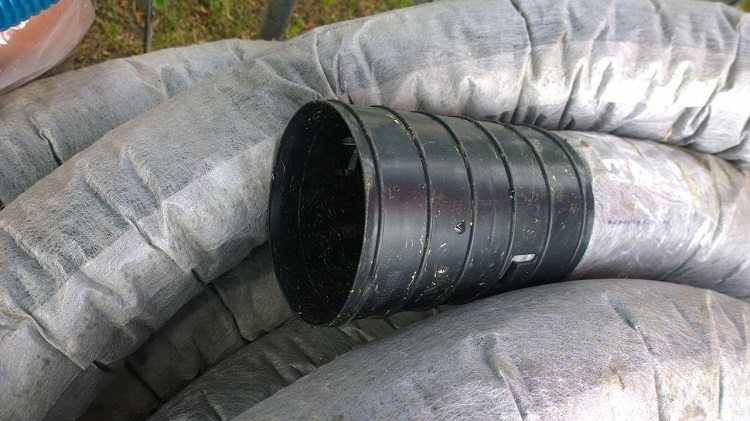
Plastic pipes equipped with a geotextile coating can significantly reduce the likelihood of clogging of the drainage system
Due to its light weight, easy transportation and installation process are provided. Their internal structure is very smooth, so almost no blockages are formed.
The best option is to use drainage pipes with geotextiles. The material acts as a filter that perfectly passes water and at the same time traps particles of soil and sand.
Note! Such a constructional device of drainage pipes allows for a long time to forget about flushing the system as a whole.
The relatively low cost and laying of the channels with your own hands is an additional advantage of their application. Drainage pipes of large diameters make it possible to design a system with significant performance.
Assortment of plastic drainage channels
Plastic corrugated ducts differ in the highest level of ring rigidity. They can be equipped with a filter shell (geotextile or coconut fiber) or not. In the assortment of outlet channels there are:
- Flexible single-layer corrugated HDPE drainage pipe with or without perforation: applicable for shallow depths, hardness class - SN4 (depth up to 3 meters) or SN2 (up to 2 m).
- Double-layer HDPE or LDPE pipe, smooth inside and corrugated on the outside: SN6 ring stiffness (recommended depth up to 4 meters), convenient for transportation and installation.
- Corrugated PVC Flexible Pipe for deep bedding: ring stiffness SN8 (depth up to 10 meters).
- The double-layer rigid HDPE pipe, smooth inside and corrugated on the outside, designed for deep drainage system: rigidity class SN8 (depth up to 8 meters), does not have a filter.
A two-layer drainage pipe is often applicable in systems with a shallow depth, since its internal smoothness can provide the most effective outflow of water and long-term functioning.
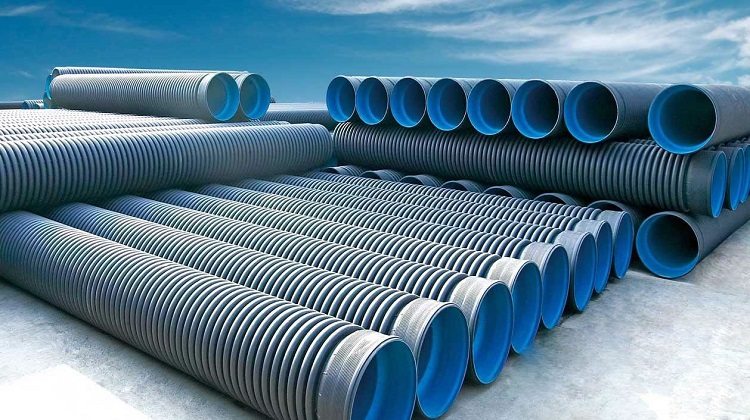
If high-strength pipes are needed for the drainage system, two-layer plastic products must be purchased
PVC products
The use of PVC drainage pipes is typical for surface installation. The diameter of such products varies from 5 to 30 centimeters. Distinguish corrugated single-layer (or two-layer) and perforated models of drainage PVC pipes.
Note! Products are well mounted on pipes of concrete and plastic wells, and latched elements are used for connection.
These designs are easy to install, however, preliminary preparation of the site will be required - the presence of a pillow from crushed stone and protection with geotextiles. PVC pipes have different classes of ring stiffness: SN16, 8, 6, 4 and SN2. The nature of the performance divides the product into hard sections of 6 and 12 meters and flexible options of 40-50 meters in the bay.
HDPE drainage pipes
HDPE pipe can be classified as stiffness class SN8 or SN4. Its physical properties allow installation to be performed in both deep and surface lines. There are such types of constructions of HDPE pipes:
- single layer;
- perforated;
- two-layer.
Possible diameters of the HDPE drainage pipe vary from 5 to 70 centimeters. Couplings, bell or welding. Some technical characteristics of such pipes are given in the table.
Table 1
| Parameter | Value for HDPE | Unit used |
| Density | 940-960 | kg / m3 |
| Linear expansion (calculated coefficient) | 0,2 | mm / (ºС * m) |
| Tensile Strength | 20 thousand to 30 thousand | kPa |
| Tensile strength at break | 19 thousand-25 thousand | kPa |
| Elongation at break, * 100 | 8 | % |
| Thermal conductivity | 420 | mW / (ºС * m) |
It is also important to note that HDPE is a combustible material.
Pipe slope
The slope of the drainage channels depends on their diameter. It should not be very large, because too fast the outflow of water will begin, which will lead to silty sediments. In this case, the pipe will soon become clogged and the drainage system needs cleaning.
On the other hand, too small a slope will lead to stagnation of water in the channel and its overflow. This is fraught with the termination of the drainage site.
The slope of the pipes is expressed in fractional numbers, which are equal to the ratio of the required slope of the outlet channel to its length in meters. For example, the required slope of 0.008 means that the height difference of 1 m. Pipe should be 8 millimeters.
Note! The smaller the pipe diameter, the greater its slope.
In practice, the value of the indicator in use for a closed type of structure is:
- 0.004 - when using crushed stone or pavers for paving surfaces;
- 0.003 - with asphalt surface coating;
- 0.005 - if the roadway or the blind area is covered with cobblestone;
- 0.003 - for drainage ditches.
Drain pipes with a diameter of 9 to 11 cm have a minimum slope of 0.02; 16 cm - 0.008; 20 cm - 0.007.
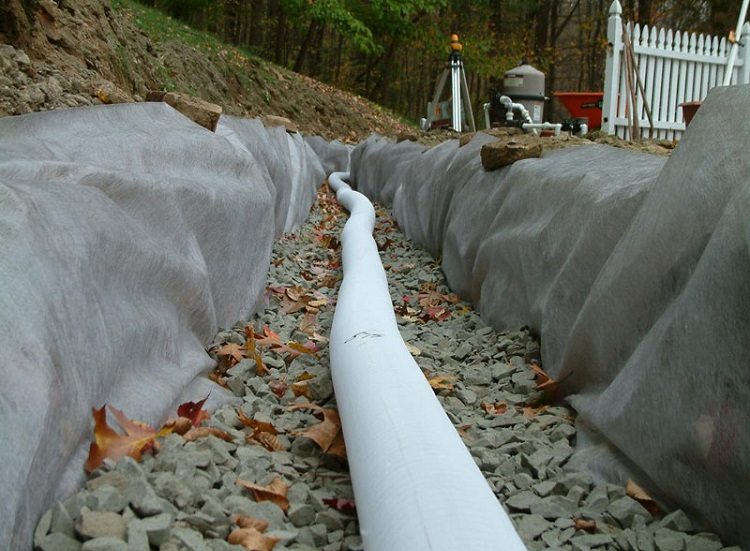
An important point when laying a drainage pipe is the slope, on which the system performance depends
Selection of drainage parameters
There are several ways of laying pipes for drainage, including head, coastal, regular and circular. The downhole installation represents the following system:
- trench of suitable depth;
- sand and gravel pillow;
- perforated pipe of the required diameter;
- geotextile filter layer.
The choice of trench depth depends on the type of rainfall in the region, the location of groundwater, and the type of soil. Before carrying out the work, it is recommended to conduct geological research. The diameter and type of pipe for drainage (single layer, double layer, corrugated, etc.) is determined based on the type of soil. It happens:
- clayey;
- loam;
- sandy;
- gravel.
For example, for sandy soil, a plastic perforated drainage pipe with a filter is well suited, for crushed stone - without it, for clay - with a filter of coconut fibers. For loam, geotextiles are acceptable, which acts as a filter.
The installation of surface channels requires compliance with the slope of the drainage pipes to the collector, where water will accumulate.
Network installation steps
Before the start of installation work, the site is marked with the location of the drainage channels. Taking into account the elevation differences, deepenings under the trench are prepared.
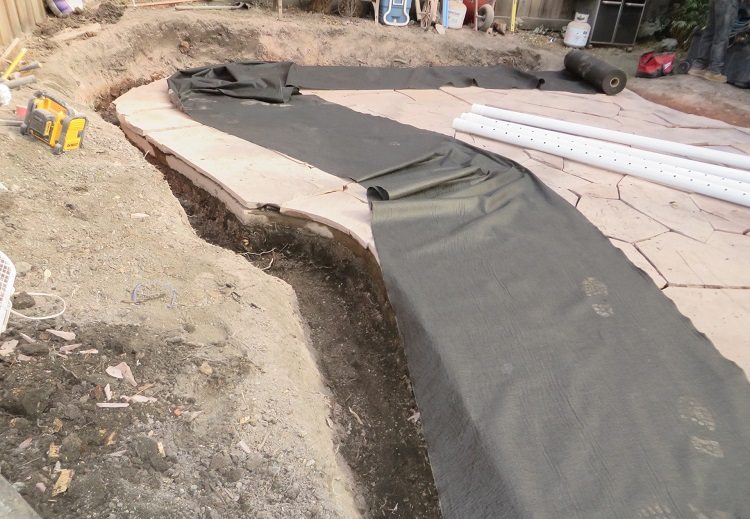
Preparation of trenches is the first and very important stage of work on the installation of a drainage system
The main task of the ditch network is unhindered and quick outflow of water.
Note! To check, you can run a certain amount of water and make sure that it does not accumulate in certain areas.
Before installing the drainage pipe, the bottom of the trench must be carefully tamped. Next, filtering material is laid, the ends of which should extend beyond the limits of the ditch, as well as to a maximum thickness of 20 cm of river sand, crushed stone.
Drain pipes are cut with a jigsaw or pipe cutter and connected with fittings. When they are wrapped with geotextile, the joints are fixed with a thin wire or rope. In addition to the throughput, the function of the filter material is to protect the perforation holes from clogging.
When laying pipes, a bias is observed, and their ends are connected to the inspection wells. Wells are divided into 2 types:
- hermetic - allow the use of collected water for technical purposes;
- absorbing - for leaving water back into the soil.
The surface of the pipe is covered with an absorbing layer of sand or gravel. At the final stage, the structure must be wrapped with a cloth of filtering material and filled with soil.
Using a drain pipe for an air conditioner
When air conditioners work inside their systems, there is a sharp temperature difference. Since they take air from the street, where a certain level of humidity is preserved, condensation appears on the walls of the air conditioning elements. Its output is made through the tube included in the kit.
Excess moisture can go outside or into the sewer network. The latter option is most acceptable, since at the first it is possible the formation of puddles or water getting on the building facade.
Note! By connecting a drainage pipe for the air conditioner to the pump, thereby ensuring a continuous drainage of water, and connecting to the sewage network, you can get a fully autonomous system.
Typically, plastic pipes are used for such purposes. It can be PVC or polyethylene. The materials are resistant to moisture, good throughput and durability.
Drainage pipes for air conditioners are smooth and corrugated. The first type is more affordable, but requires the use of fittings for sharp bends and bends. Corrugated products are more preferable because they have excellent elasticity while maintaining all the advantages of plastic.
Installation Errors
Mistakes made when planning or installing a drainage network can affect its efficiency and overall durability.
Note! Care must be taken in combining deep and surface drainage.
The most common errors in laying a drainage system include:
- selection of a pipeline network without regard to soil type;
- violation (change, absence) of the angle of the system;
- lack of drainage from the well of collected water;
- violation of the technology for arranging a drainage pipe (without dumping sand and gravel);
- lack of filter material and geotextiles;
- poor connection of pipes;
- missing pipe perforation.
Double-layer, single-layer, corrugated, PVC drainage pipe, HDPE - these are all types of drainage channels that can be used to drain the site. Some types are included in the package of air conditioners and other equipment. The characteristics of such pipes allow them to perfectly cope with their task and not lose properties over the years.
